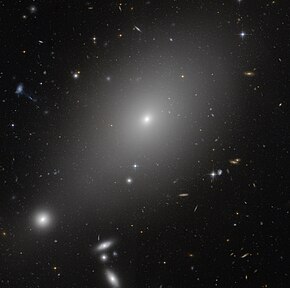
Star clusters are large groups of stars held together by self-gravitation. Two main types of star clusters can be distinguished. Globular clusters are tight groups of ten thousand to millions of old stars which are gravitationally bound. Open clusters are more loosely clustered groups of stars, generally containing fewer than a few hundred members, that are often very young. As they move through the galaxy, over time, open clusters become disrupted by the gravitational influence of giant molecular clouds. Even though they are no longer gravitationally bound, they will continue to move in broadly the same direction through space and are then known as stellar associations, sometimes referred to as moving groups.

The Very Large Telescope (VLT) is an astronomical facility operated since 1998 by the European Southern Observatory, located on Cerro Paranal in the Atacama Desert of northern Chile. It consists of four individual telescopes, each equipped with a primary mirror that measures 8.2 meters in diameter. These optical telescopes, named Antu, Kueyen, Melipal, and Yepun, are generally used separately but can be combined to achieve a very high angular resolution. The VLT array is also complemented by four movable Auxiliary Telescopes (ATs) with 1.8-meter apertures.
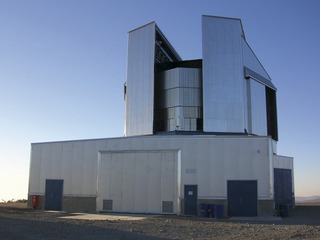
The VISTA is a wide-field reflecting telescope with a 4.1 metre mirror, located at the Paranal Observatory in Chile. It is operated by the European Southern Observatory and started science operations in December 2009. VISTA was conceived and developed by a consortium of universities in the United Kingdom led by Queen Mary University of London and became an in-kind contribution to ESO as part of the UK's accession agreement, with the subscription paid by the UK Science and Technology Facilities Council (STFC).

The Antennae Galaxies are a pair of interacting galaxies in the constellation Corvus. They are currently going through a starburst phase, in which the collision of clouds of gas and dust, with entangled magnetic fields, causes rapid star formation. They were discovered by William Herschel in 1785.

Interacting galaxies are galaxies whose gravitational fields result in a disturbance of one another. An example of a minor interaction is a satellite galaxy disturbing the primary galaxy's spiral arms. An example of a major interaction is a galactic collision, which may lead to a galaxy merger.

NGC 1097 is a barred spiral galaxy about 45 million light years away in the constellation Fornax. It was discovered by William Herschel on 9 October 1790. It is a severely interacting galaxy with obvious tidal debris and distortions caused by interaction with the companion galaxy NGC 1097A.

Arp 107 is a pair of interacting galaxies located about 450 million light-years away in the constellation Leo Minor. The galaxies are in the process of colliding and merging.

An extremely large telescope (ELT) is an astronomical observatory featuring an optical telescope with an aperture for its primary mirror from 20 metres up to 100 metres across, when discussing reflecting telescopes of optical wavelengths including ultraviolet (UV), visible, and near infrared wavelengths. Among many planned capabilities, extremely large telescopes are planned to increase the chance of finding Earth-like planets around other stars. Telescopes for radio wavelengths can be much bigger physically, such as the 300 metres aperture fixed focus radio telescope of the Arecibo Observatory. Freely steerable radio telescopes with diameters up to 100 metres have been in operation since the 1970s.
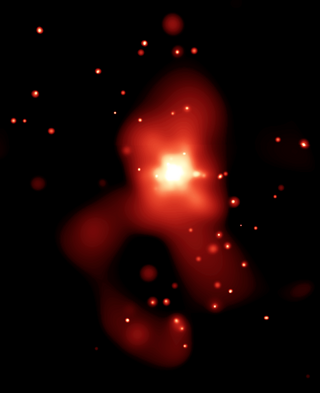
NGC 4261 is an elliptical galaxy located around 100 million light-years away in the constellation Virgo. It was discovered April 13, 1784, by the German-born astronomer William Herschel. The galaxy is a member of its own somewhat meager galaxy group known as the NGC 4261 group, which is part of the Virgo Cluster.
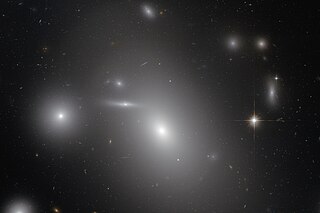
NGC 4889 is an E4 supergiant elliptical galaxy. It was discovered in 1785 by the British astronomer Frederick William Herschel I, who catalogued it as a bright, nebulous patch. The brightest galaxy within the northern Coma Cluster, it is located at a median distance of 94 million parsecs from Earth. At the core of the galaxy is a supermassive black hole that heats the intracluster medium through the action of friction from infalling gases and dust. The gamma ray bursts from the galaxy extend out to several million light years of the cluster.

The type-cD galaxy is a galaxy morphology classification, a subtype of type-D giant elliptical galaxy. Characterized by a large halo of stars, they can be found near the centres of some rich galaxy clusters. They are also known as supergiant ellipticals or central dominant galaxies.

Hyper-Luminous X-ray source 1, commonly known as HLX-1, is an intermediate-mass black hole candidate located in the lenticular galaxy ESO 243-49 about 290 million light-years from Earth. The mass of its central black hole is estimated to be approximately 20,000 solar masses. The source was discovered at the Institut de Recherche en Astrophysique et Planétologie, Toulouse, France and gained interest from the scientific community because of strong evidence supporting it as an intermediate-mass black hole. HLX-1 is possibly the remnant of a dwarf galaxy that may have been in a galactic collision with ESO 243-49.

DDO 190 is a dwarf irregular galaxy in the vicinity of the Milky Way, as it is relatively small and lacks clear structure. It is 9.10 million light-years (2.79 Mpc) away from Earth and lies out of the Local Group, determined by the tip of the red giant branch method. The outskirts of the galaxy are harbouring older (reddish) stars, while the centre is crowded with younger (bluish) stars. Heated gas is observed at several places. DDO 190 still experiences some active star formation. The galaxy is categorised as a Magellanic dwarf galaxy of morphological type Im. Its metallicity is [Fe/H] = −1.55 ± 0.12.

ESO 444-46 is a class E4 supergiant elliptical galaxy; the dominant and brightest member of the Abell 3558 galaxy cluster around 195 megaparsecs away in the constellation Centaurus. It lies within the core of the massive Shapley Supercluster, one of the closest neighboring superclusters. It is one of the largest galaxies in the local universe, and possibly contains one of the most massive black holes known. The black hole's mass is very uncertain, with estimates ranging from as low as 501 million M☉, to as high as 77.6 billion M☉.

NGC 759 is an elliptical galaxy located 230 million light-years away in the constellation Andromeda. NGC 759 was discovered by astronomer by Heinrich d'Arrest on September 17, 1865. It is a member of Abell 262.

ESO 325-4 is an elliptical galaxy located approximately 416 million light-years away in the constellation Centaurus.

NGC 4318 is a small lenticular galaxy located about 72 million light-years away in the constellation Virgo. It was discovered by astronomer John Herschel on January 18, 1828. NGC 4318 is a member of the Virgo W′ group, a group of galaxies in the background of the Virgo Cluster that is centered on the giant elliptical galaxy NGC 4365.
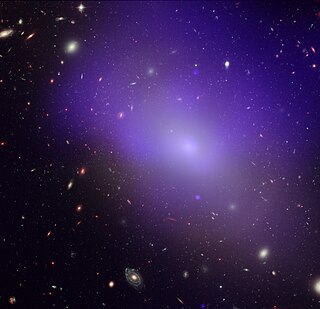
NGC 1132 is an elliptical galaxy located in the constellation Eridanus. The galaxy was discovered by John Herschel on November 23, 1827. It is located at a distance of about 318 million light-years away from Earth.

NeVe 1 is a supergiant elliptical galaxy, which is the central, dominant member and brightest cluster galaxy (BCG) of the Ophiuchus Cluster. It lies at a distance of about 411 million light-years away from Earth and is located behind the Zone of Avoidance region in the sky. It is the host galaxy of the Ophiuchus Supercluster eruption, the most energetic astronomical event known.

ESO 383-76 is an elongated, X-ray luminous supergiant elliptical galaxy, residing as the dominant, brightest cluster galaxy (BCG) of the Abell 3571 galaxy cluster, the sixth-brightest in the sky at X-ray wavelengths. It is located at the distance of 200.6 megaparsecs from Earth, and is possibly a member of the large Shapley Supercluster. With a diameter of about 540.89 kiloparsecs, it is one of the largest galaxies known. It also contains a supermassive black hole, one of the most massive known.
